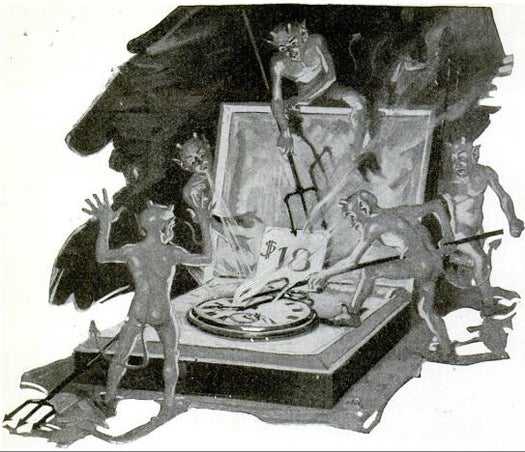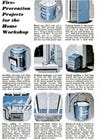It’s a shame that you can’t actually fight fire with fire. That would be cool. And dangerous. Fire’s great when you’re studying the behavior of a flame on the International Space Station or making your animatronic dragon more realistic, but it’s even more great when you’re not being burned alive, so be cool about fire safety.
For National Fire Prevention Week, we bring you fire safety tips and technology courtesy of PopSci writers and fire enthusiasts past. Be careful about that watch you’re wearing–it could erupt into flames!
_
See the gallery._
Don’t Leave Your Watch Unattended, September 1917
Evidently firefighting was a tough game to play for the people of Norwich in 1917. A wristwatch with a piece of paper caught in it, a magnifying glass, and the sun’s rays together translated into a fire which went undetected until it morphed into a mighty conflagration because no one wanted to be outside in the snow that Sunday. Sounds like #firstworldproblems. The writer said that even if people are around for a fire, it can grow out of control quickly for these apparently common reasons: “The fire-bucket was empty.” “The fire-hose was too far away.” “Somebody lost his head.” “Nobody could operate the extinguisher.” This “story” is actually a cleverly disguised advertorial for Grinnell Automatic Sprinkler System, so maybe (hopefully) it’s not true. Otherwise, the people of Norwich certainly should’ve gotten their acts together. Read the full story in The Watch That Caused A Fire!
Asbestos… For Safety? October 1948
The National Fire Prevention Association, The National Board of Fire Underwriters and the Fire Protection Institute helped us draft this lengthy fire safety feature in 1948 with every tip imaginable for having the safest home of all time– safe from flames at least. There’s a funny disclaimer saying “this does not imply their approval of the devices illustrated or described.” That was a smart move for them. Our science had not fully caught up to us when we suggested asbestos for fireproofing homes: “False ceiling of asbestos sheeting or gypsum board over furnace insures against instant firing of tinder-dry joists and flooring in case of blowback and sudden flames. Ordinary fiberboard retards flame only a third as long as asbestos.” Read the full story in Your Home: Your Own Firetrap.
Practice Makes Perfect, July 1920
Once upon a time, telephone switchboards were in danger of catching on fire. New York Telephone Company held a fire-fighting exhibition (read:contest) in order to teach their workers how to put out fires. They gathered the watchmen in a Brooklyn backyard and gave them equipment to put out switchboard fires. The flames started small, but as the watchmen started to get the hang of it, they began putting out bigger and bigger fires. New York Telephone Company really knows how to be productive while having fun. It seems really obvious– the best way to teach people to fight fires in the workplace is to create one (in a semi-controlled environment.) No one does this anymore. Read the full story in Learning to Fight a Switchboard Fire.
No Ordinary Fire, November 1920
Coal mine fires usually occur in unpopulated areas where they are left to burn themselves out. In 1914, a fire started in an abandoned coal mined under a residential section of Pittsburgh. This wasn’t a job that firefighters could tackle– they needed scientists, engineers. At the time of writing in 1920, the fire was still burning. Engineers at first tried to left the fire burn out, but it soon became clear that wouldn’t happen. They then decided to excavate as much coal from the area as possible to remove any fuel from the fire. Coal became so readily available in the town that people could buy one ton for one dollar. Read More In Fighting A Burning Coal Mine Under A City.
Indoor Sprinklers, October 1982
In the 1980s, we introduced this supercool fire safety DIY project that only put you out about $700 if you installed it yourself. The only catch was that you had to be a “fairly handy home plumber” to do it. Still, whether you built it yourself or had someone install it in your house for you, we were pretty stoked about residential sprinkler systems for small homes. A little bit of fire research went a long way in breaking through this new technology. > “The most significant breakthrough is what we’ve learned about the special characteristics of residential fires,” says Harry Shaw of the U.S. Fire Administration. As a result, there are now sprinkler heads designed specifically to fight residential fires using the ordinary, low-pressure, household water supply . Read more in Home Fire Sprinklers.
Swatting The Firebugs, February 1936
As if there aren’t enough fire-related safety issues to be worried about, some people actually like to start them for kicks. Luckily, even in 1936, we had some firebug insurance. These are the guys that catch the pyro perps. > Backtracking the fire through its wake of smoking embers came the Forest Service G-Men–trained investigators who combine the magic of microscope, test tube, and camera with the secrets of Indian woodcraft, and possess a seemingly uncanny ability to detect the work of a firebug and track him down.
>
> ? Read More in New Scientific Woodcraft Traps Forest Fire Fiends.
The Smoke-Eater’s Fancy Ride, January 1947
Miraculously, firemen still have jobs even after this post-war fire engine technology debuted. PopSci wrote in 1947 that firetrucks would steal the “smoke-eater’s” thunder. These new machines were faster and better-designed than the old trucks and eliminated the need for a tillerman, “that magnificent muscled creature who wrestles the steering wheel on the backend.” > The firemen will grouse and lob tobacco juice into their spitoons until they learn more about this new equipment. Then, gradually, they will discover that a new day in firefighting is dawning. For the first time, equipment to fight fires is being made for more than a rough purpose. Read the full story in Here Come The New Fire Engines.
Fire-fighting Robots, November 1983
It sounds like a children’s television program but it’s actually a real thing–robots that fight fire. Awesome. The robot pictured, entitled “Snail,” carryies water lines into fire. The article also features computers, proximity suits, aerial ladder trucks, and helicopters. Jack Girard of the National Fire Protection Association predicted the following for fire-fighting technology in years to come: “We will see integrated computerized communication systems in extensive use on vehicles and in stations and greater use of helicopters in city fires and airplanes in rural fires. We also expect even more improvement in protective clothing (complete with built-in breathing systems, and more use of robots–with television and radio adaptations.” Read more in Now Computers And Robots Join The Fight Against Fire.








